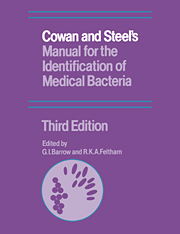Book contents
- Frontmatter
- Contents
- Foreword
- Preface to the first edition
- Postscript
- Preface to the second edition
- Preface to the third edition
- List of contributors
- Introduction
- 1 Classification and nomenclature
- 2 Culture media: constituents and sterilization
- 3 Principles of isolation
- 4 Bacterial characters and characterization
- 5 Theory and practice of bacterial identification
- 6 Characters of Gram-positive bacteria
- 7 Characters of Gram-negative bacteria
- 8 Taxonomy in theory and practice
- 9 Bacterial identification by cards
- 10 Bacterial identification by computer
- 11 Quality control in microbiology
- Appendices
- References
- Index
8 - Taxonomy in theory and practice
Published online by Cambridge University Press: 15 December 2009
- Frontmatter
- Contents
- Foreword
- Preface to the first edition
- Postscript
- Preface to the second edition
- Preface to the third edition
- List of contributors
- Introduction
- 1 Classification and nomenclature
- 2 Culture media: constituents and sterilization
- 3 Principles of isolation
- 4 Bacterial characters and characterization
- 5 Theory and practice of bacterial identification
- 6 Characters of Gram-positive bacteria
- 7 Characters of Gram-negative bacteria
- 8 Taxonomy in theory and practice
- 9 Bacterial identification by cards
- 10 Bacterial identification by computer
- 11 Quality control in microbiology
- Appendices
- References
- Index
Summary
As a subject, taxonomy is often regarded as dull and uninspiring. With understanding, however, it can be stimulating and exciting, as indeed were the personal and sometimes unorthodox views expressed by Cowan in the previous edition of this Manual. Moreover, taxonomy is fundamental to the application and use of the increasingly available commercial identification kits now used so widely for medical (and other) bacteria so that knowledge of the basic principles concerned is perhaps more than ever essential.
The application of taxonomy, as a science, to bacteriology took a long time. Bulloch's (1938) History of Bacteriology, Brock's (1961) Milestones in Microbiology and Postgate's (1969) Microbes and Man epitomise the applied and practical nature of early bacteriology. This was concerned chiefly with ‘diseases’ of wine, plants and animals, and little thought was given to theoretical aspects such as taxonomy. The main lines of investigation were to determine causes and, if possible, find cures, from which diagnostic bacteriology and preventive medicine developed. To the early medical bacteriologists, the systematic classification of bacteria was not essential. Indeed it was not until botanists who took an interest in these ‘new’ and strange organisms tried to apply variations of their own classical rules for naming them that bacterial taxonomy first began. By and large medical bacteriologists were content to let bacterial names look after themselves; they used names which were meaningful to them in relation to illness, such as ‘Bacillus typhosus’ or more generally ‘the typhoid bacillus’.
- Type
- Chapter
- Information
- Publisher: Cambridge University PressPrint publication year: 1993



